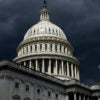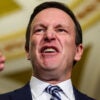Editor’s note: The following is a lightly edited transcript of the accompanying video from professor Peter St. Onge.
What does Trump 2.0 mean for the economy?
Last week, Donald Trump sat with news outlet Bloomberg for an in-depth interview on his economic plans. ZeroHedge wrote up a great summary.
The Daily Signal depends on the support of readers like you. Donate now
In short, Trump plans more of what he did first time around: Lower taxes—he’s floating 15% rates. Slashing red tape; drill baby drill; and new tariffs, especially on the Chinese—which Trump again floated as a replacement for the income tax, which would be glorious if it came to pass.
He plans to end the foreign wars, including Ukraine and a theoretical war over Taiwan. And, of course, he plans to lock the border and deport 10 million-plus illegal aliens Joe Biden imported.
On the Fed, Trump plans to keep Jerome Powell until his term ends in early 2026—note that it’s nearly impossible to remove a sitting Fed chair before his term ends. He thinks the Fed should hold off rate cuts since inflation isn’t tamed yet, which is correct.
The political background here is that inflation and jobs remain the top issue for American voters, and the numbers for Biden are only getting worse. Yes, even the official numbers. Biden’s losing working class voters, he’s losing Hispanics, he’s even losing black men who are a pillar of the Democrat coalition.
This actually plays directly into Trump’s strength—his economic management. Last time around, Trump took an anemic Obama economy and delivered nearly 3% real growth per year, drove unemployment from almost 5% under Obama to just 3.5%. He kept inflation low—it was 1.4% when Trump left office, down from Obama’s final read of 2.6%. Note that was 1.4% even with Trump’s tariffs on China.
The one part that’s missing is spending restraint—getting federal spending down to the point where it stops feeding inflation. I mentioned in a recent video that Trump’s been about average on spending, comparable to Bush or Obama. Still, that’s a damn sight better than Biden, who’s greenlighted activist utopia with a trillion-dollar price tag on it.
Granted, we could see savings from ending the forever wars and deporting millions of illegals, but ideally, we’d go full [Argentinian President] Javier Milei, canceling entire departments like the Department of Education, foreign aid, or—God willing—the IRS.
I have no doubt Trump would like to do these things. But every federal dollar has a political cost to eliminating it, so I understand the political reality, especially before the election.
So what’s next?
Beyond what Trump plans to do, the question is, can he get it through Congress? Betting markets are currently putting Trump at 68% chance of winning—keep in mind that betting markets, in theory, capture the margin of cheating.
They give even higher odds for a GOP Senate—78%, albeit with a slim 52 to 48 margin vulnerable to RINOs [Republicans in Name Only]. But those same markets say it’s 50/50 who controls the House, where bills have to originate.
So, the question is whether Trump’s coattails—or Joe Biden’s stink—carry enough down-ballot congressional races. If voters deliver Trump a workable Congress, then he could quickly pass tax cuts and deregulation that would start taking the edge off inflation. But to actually wipe out inflation would take getting Javier Milei-level spending cuts through Congress.
The other elephant in the room is the recession. Taxes and deregulation make us rich in the long run, but it takes time for new businesses to start, existing businesses to expand, or new factories to be built. So, it may be too late to skip the downturn, even as we build a stronger foundation for the future.
We publish a variety of perspectives. Nothing written here is to be construed as representing the views of The Daily Signal.






























